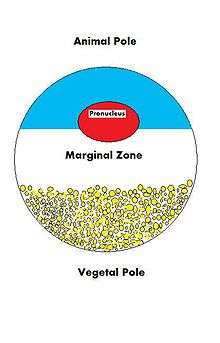Polarity in embryogenesis
In developmental biology, an embryo is divided into two hemispheres: the animal pole and the vegetal pole within a blastula.

The animal pole consists of small cells that divide rapidly, in contrast with the vegetal pole below it. In some cases, the animal pole is thought to differentiate into the later embryo itself, forming the three primary germ layers and participating in gastrulation. The animal pole is heavily pigmented while the vegetal pole remains unpigmented.[1]
The vegetal pole contains large yolky cells that divide very slowly, in contrast with the animal pole above it. In some cases, the vegetal pole is thought to differentiate into the extraembryonic membranes that protect and nourish the developing embryo, such as the placenta in mammals and the chorion in birds.
The development of the animal-vegetal axis occurs prior to fertilization.[2] Sperm entry can occur anywhere in the animal hemisphere.[3] The point of sperm entry defines the dorso-ventral axis - cells opposite the region of sperm entry will eventually form the dorsal portion of the body.[2][4]
In the frog Xenopus laevis, a pigment pattern provides the oocyte with features of a radially symmetrical body with a distinct polarity. The animal hemisphere is dark brown, and the vegetal hemisphere is only weakly pigmented. The axis of symmetry passes through on one side the animal pole, and on the other side the vegetal pole. The two hemispheres are separated by an unpigmented equatorial belt. Polarity has a major influence on the emergence of the embryonic structures. In fact, the axis polarity serves as one coordinate of geometrical system in which early embryogenesis is organized.[5]
Naming
The animal pole draws its name from its liveliness relative to the slowly developing vegetal pole. Hence the vegetal pole is named for its relative inactivity relative to the animal pole.
References
- Wolpert, Lewis; Tickle, Cheryll; Martinez Arias, Alfonso (2015). Principles of Development (5th ed.). Oxford University Press. p. 146. ISBN 9780198709886. Retrieved 12 October 2015.
- Gilbert SF. Developmental Biology. 6th edition. Sunderland (MA): Sinauer Associates; 2000. Early Amphibian Development. Available from: https://www.ncbi.nlm.nih.gov/books/NBK10113/
- Wolpert, Lewis; Tickle, Cheryll; Martinez Arias, Alfonso (2015). Principles of Development (5th ed.). Oxford University Press. p. 149. ISBN 9780198709886. Retrieved 12 October 2015.
- Angerer, Lynne M.; Angerer, Robert C. (February 2000). "Animal–Vegetal Axis Patterning Mechanisms in the Early Sea Urchin Embryo". Developmental Biology. 218 (1): 1–12. doi:10.1006/dbio.1999.9553. PMID 10644406.
- P. Hausen, M. Riebesell: The Early Embryonic Development of Xenopus Laevis - An Atlas of the Histology ISBN 0387537406